6 Process Mining Trends to Watch for in 2024
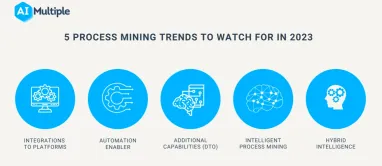
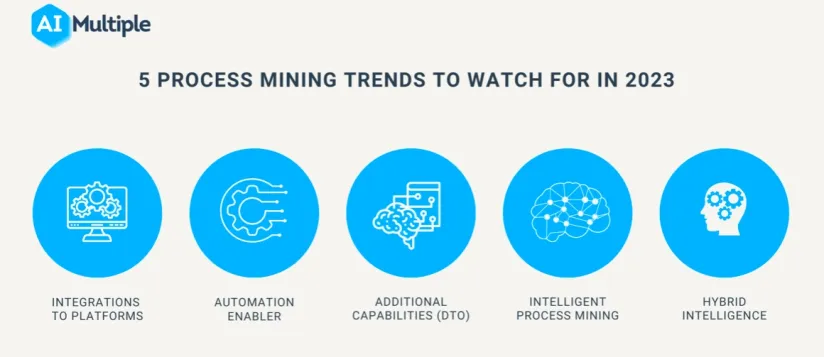
Process mining has evolved into a mainstream approach to discover and improve business processes, and its market is projected to grow by 40-50% by passing $1 billion in 2022. 1 It is being applied to numerous sectors and departments, ranging from healthcare to logistics. Case studies have shown that retailers, telco, and finance companies were some of the top beneficiaries of process mining.
In this article, we explore experts’ opinions, and we leverage our own research to predict process mining trends in 2023, and how businesses can benefit from these trends.
1. Integration with other platforms
Wil van der Aalst, whose work laid the academic foundations of process mining, states that he observes a shift towards more integrated tools and capabilities in the process mining market.2
Acquisitions contribute to the increase in the number of integrations:
- Tech giants have started to acquire process mining solutions (e.g. IBM with myInvenio, SAP with Signavio)
- Vendors merge process mining with different platforms, specifically automation platforms (e.g. IBM Cloud Pak for Business Automation).
2. Process mining as automation enabler
A typical problem in process automation efforts is the lack of understanding of the underlying business process. Process mining allows companies to analyze and visualize processes. By doing so, process mining helps discover areas to implement process automation. In Gartner’s market guide in 2019, businesses were mostly interested in process mining as a way to improve business processes. However, by 2022, it is estimated that businesses will focus their use of process mining to drive digital transformation. (See Figure 1)

In some cases, process mining assists RPA projects by revealing insights about the ongoing automation processes. It is estimated that half of the RPA projects tend to fail or does not meet the measured ROI. 3 Process mining helps discover the processes involved in RPA projects. It ensures businesses identify the root causes of problems and deviations and predict the bottlenecks and failure points to improve in these projects.
For example, Piraeus Bank employed process mining to detect bottlenecks, and root causes of the issues in their automation project, which helped them to automate their loan application processes by shortening the time from 35 minutes to 5 minutes.
3. Process mining is overtaking the BPM market
Since 2015, searches for process intelligence and related terms such as process mining and process discovery have been increasing. Google traffic for this year was twice as high as the traffic during 2016. The searches for business process management (BPM) show parallel trends, indicating that process intelligence and process mining have become central tools for managing and improving business processes.
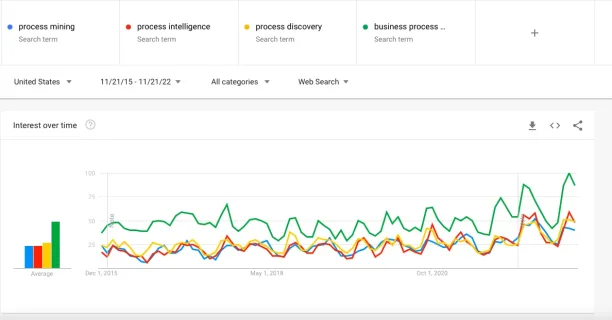
Meanwhile, interest in process improvement techniques (methodologies), such as Kaizen, six sigma and total quality management, has slightly decreased, although they still hold significant traffic.
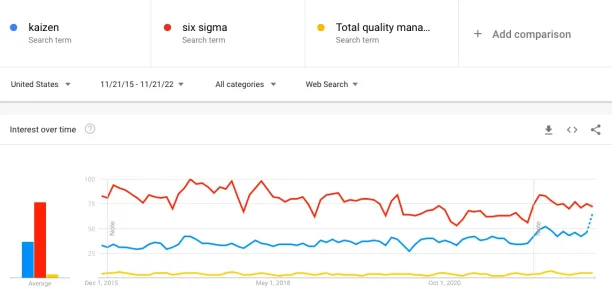
Similar trends are observed in academic studies. From 1995 to 2019, the number of books published on process intelligence exceeded that of books on process improvement techniques.
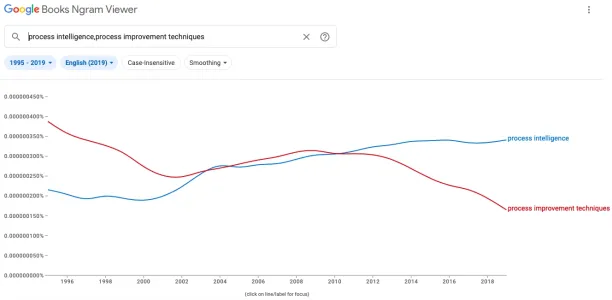
Specifically, the number of process mining books has been accelerating while the books published on six sigma have decreased since 1995. In 2014, the number of books published on process mining passed the number of books on six sigma.
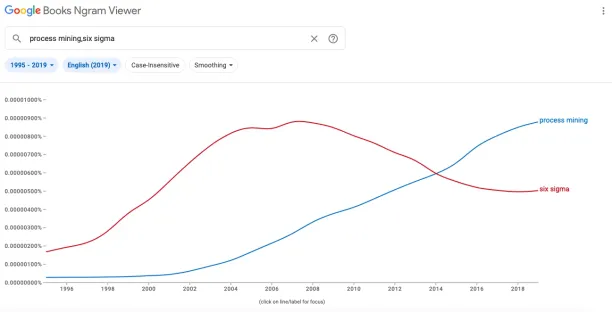
4. Additional capabilities
Process mining vendors offer additional capabilities to complement process mining, which are task mining, predictive analytics feature, and process simulation capabilities, such as Digital twins of organization technology (DTO). Figure 6 shows the interest in these tools on Google searches. Although the overall traffic for task mining and process simulation remains lower than process mining, there has been some interest in the tools since 2015.
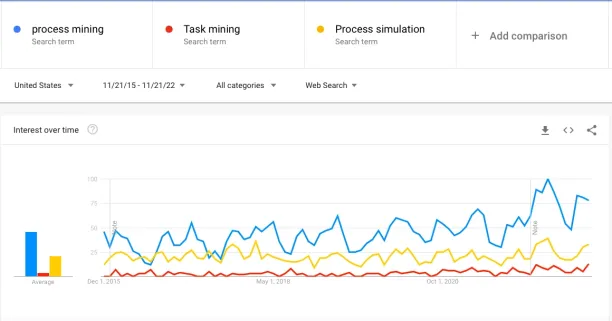
DTO
DTO emerges as an application of digital twin technology combined with process mining which focuses on discovering, optimizing and simulating an organization’s processes. DTO enables companies to run numerous what if scenarios and make optimal decisions.
However, DTO is a topic of emerging research in process mining and we have not yet seen enterprise clients use such techniques frequently in production.
To discover how process mining improves DT, feel free to read our article.
Predictive analytics
Process mining users are asking for more than simple Directly Follows Graphs (DFGs) to discover processes, and are searching for ways to incorporate technologies that can offer conformance checking, prediction, and simulation, such as Business Process Model and Notation (BPMN). For example, Gartner listed predictions among top 10 capabilities of process mining for 2021. 4 Enterprise users are expecting more predictive capabilities from process mining.
Predictive analytics and results of scenario analysis of DTO serve the same aim: Helping enterprises make optimal process related decisions.
Task mining
Task mining technology captures user interactions on websites and desktop and shows how employees/users perform their tasks. This solution can be useful to monitor user actions, assess employee performance and identify mistakes and issues in execution of such tasks. Businesses can improve their task efficiency, enable automation and ensure compliance, as result of task mining benefits.
Process mining software analysis and comparison we conducted show that several vendors offer two tools in one package or task mining as an additional capability. Leveraging these two solutions together provides more comprehensive data and ensures a successful process transformation.
Explore five major differences between process mining and task mining.
Multi-level process mining
Multi-level process mining (MLPM) deals with complex processes, such as procure to pay (P2P) and order to cash (O2C). Traditionally, process mining algorithms struggle to discover, model and map these complicated processes and oversimplified them.
Multi-level process mining can track the interactions between various process entities and ensures accurate and detailed analysis.
Read our multi-level process mining article to learn how it works in detail, what are the examples, and how to verify it.
5. AI-powered process mining
Though researchers and vendors are using AI increasingly in process mining, the practical use of these tools is still limited according to Wil van der Aalst because of
- Constantly changing state of processes limit data availability for ML based approaches
- ML based approaches require significant volumes of steady state data for high performance.
Machine learning and AI help automate process mining activities and bring ease to modeling and prediction features. For example, there are machine learning algorithms which allow users to model and discover business processes using Python, R, Java and other languages. Discover top machine learning process mining applications.
In addition, AI technologies are applied to process discovery to identify human interactions with the help of computer vision, leverage automation in discovery of workflows and modeling, in order to shorten the time of process mining solution implementation. These use cases advance process discovery over manual process discovery. Therefore, some vendors and academics refer to AI powered process discovery as automated process discovery.
There are RPA, analytics and process mining companies providing automated process discovery tools. To learn more on the process discovery tools, read our comprehensive article on process discovery tools.
Machine learning is going to play a bigger part in process mining once organizations have cleaner process data and once process mining tools pull data from most enterprise systems thanks to integrations. Therefore, traditional process mining techniques like manual process discovery and conformance checking will continue be applied in 2022.
6. Hybrid intelligence (HI)
Though vendors and businesses are interested in AI capabilities of process mining tools, human intelligence will remain critical in the field of process mining. Human intelligence (HI) underlines the assistive role of new data-driven technologies to connect human and artificial intelligence to reach more accurate results. Specifically for process mining, HI is apparent in developments of object-centric and action-oriented process mining (OCPM and AOPM).
OCPM strives to overcome the single object assumption of process mining tools. Process mining tools rely on the belief that there is a single case identifier. Yet, in reality, one event can refer to multiple objects (e.g., a customer, multiple items, and a location).
AOPM helps turn observed events into management actions to guide the operational system. AOPM automates correcting of activities that are diagnosed by process mining. In AOPM, human intervention is critical to clarify the unprecedented situations.
Further Reading
To learn more about process mining, PM tools and use cases, feel free to read our in-depth articles:
- 33 Use Cases / Applications of Process Mining
- Top 10 Open Source and Free Trial Process Mining Tools
If you believe your business can benefit from process mining tools, you can check our data-driven list of process mining software and other automation solutions.
Check out our comprehensive and constantly updated process mining case studies list to learn more real-life examples.
Assess different vendors with a transparent methodology yourself by downloading our checklist:
And you can let us find you the right vendor:
External Links
- 1. Kerremans, Marc; Searle, Samantha; Srivastava, Tushar; Iijima,Kimihiko (2020). “Market Guide for Process Mining.” Gartner. Revisited January 4, 2023.
- 2. “Wil van der Aalst.” Wikipedia. December, 2022. Revisited January 4, 2023.
- 3. “Successful implementation of RPA takes time.” PWC. 2017. Revisited January 4, 2023.
- 4. Kerremans, Marc; Searle, Samantha; Srivastava, Tushar; Iijima,Kimihiko (2020). “Market Guide for Process Mining.” Gartner. Revisited January 4, 2023.

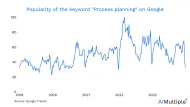
![51 Process mining case studies & project results [2024 update]](https://research.aimultiple.com/wp-content/uploads/2019/09/process-mining-case-studies-190x107.png.webp)
Comments
Your email address will not be published. All fields are required.